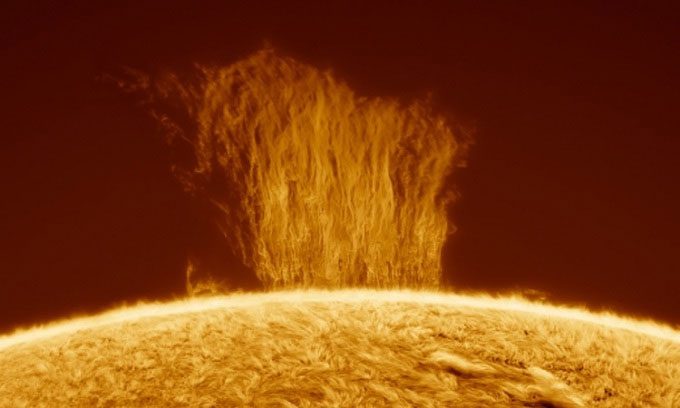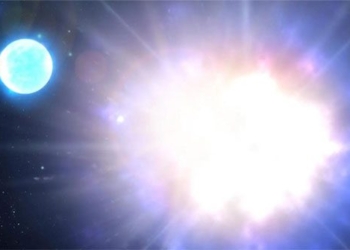An astrophotographer captured images of a massive plasma wall collapsing onto the surface of the Sun at super-fast speeds after erupting near the star’s southern pole.
Photographer Eduardo Schaberger Poupeau, located near Rafaela, Argentina, took the photo on March 9 using specialized camera equipment. The plasma wall rises to a height of 100,000 kilometers above the Sun’s surface, equivalent to stacking eight Earths on top of each other. “On my computer screen, it looked like hundreds of plasma strands flowing down from the wall,” Poupeau shared.

Close-up of the 100,000 km high plasma wall, also known as a plasma waterfall, near the southern pole of the Sun. (Photo: Eduardo Schaberger Poupeau)
This phenomenon is known as polar crown prominences (PCP), according to Spaceweather.com. Essentially, PCPs are similar to regular solar prominences. They are streams of plasma or ionized gas that erupt from the star’s surface due to magnetic fields. However, PCPs occur near the Sun’s magnetic poles, between 60 – 70 degrees North and 60 – 70 degrees South, causing them to collapse back onto the surface due to stronger magnetic fields near the poles, as explained by NASA. This collapsing process gives them the nickname “plasma waterfalls.”
The plasma within PCPs typically does not fall freely as it remains confined within the magnetic field. However, the plasma slides down at speeds of up to 36,000 km/h, exceeding the magnetic field’s holding capacity, according to experts’ calculations. Researchers are still investigating how this occurs. A study published in 2021 in the journal Frontiers in Physics revealed that PCPs go through two phases during their eruption: a slow phase where plasma gradually shoots upward and a fast phase where plasma accelerates toward its peak. The process may affect how plasma falls back to the surface, but further research is needed for confirmation.
Solar physicists often study prominences because they accompany coronal mass ejections, which are columns of ionized plasma that break away from the Sun and head directly toward Earth. However, PCPs are also of great interest to nuclear physicists because the Sun’s magnetic field seems particularly suited to contain plasma flows at the poles, potentially aiding researchers in improving experimental fusion reactors.
PCPs are quite common and can occur almost daily, although photographs of such phenomena like Poupeau’s are rare. However, like many other plasma-related events on the Sun, PCPs may become more frequent and intense as the Sun approaches the peak of its 11-year cycle, known as solar maximum.





















































